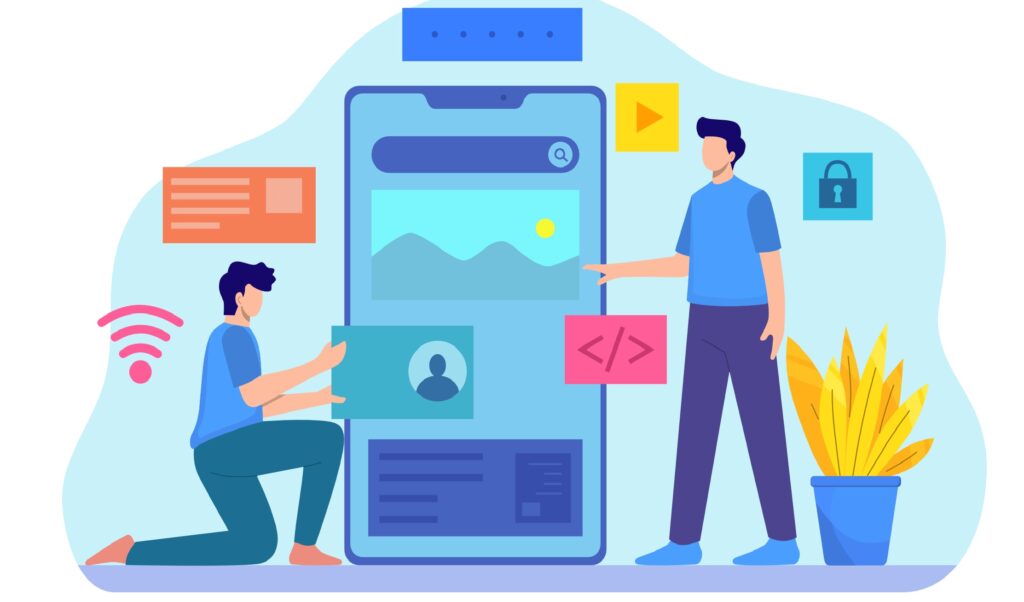Did you know that in 2022, the Google Play Store had over 2.56 million apps? The number is just increasing and, as one could anticipate, one of the most profitable enterprises nowadays is the mobile app industry. Are you interested in focusing on developing an app? Have you got a great app concept that could turn into a successful business?
It’s natural if the app development process seems difficult at first. Developing a mobile app from the bottom up is a complex process with many levels of details and various touchpoints. Developing an app is a significant financial investment; nevertheless, approaching it correctly is the key to making it worthwhile. As a result, by streamlining your strategy, you’ll be able to extract maximum value for your consumers and your company in a systematic way.
The app development process begins with extensive planning, as a company hiring an app developer must have a clear understanding of their goals. Once you get into the essentials of development, you’ll have to think about a lot of things, like whether you’re looking to build for one platform or numerous platforms, and how you’re going to commercialize your app.
This blog will assist you in understanding the various app development stages for your future project. Have a look at this comprehensive app development checklist that you must follow when developing an app. It will assist you in swiftly validating and launching your app idea.
1. The Complete Checklist to Build a Mobile App
Here below is the comprehensive checklist to build a mobile app.
1.1 Determine the app’s objectives
To begin, you must establish your business objectives and how the app will assist you in achieving them. You should devise a strategy that defines the app’s essential functions as well as any other features you believe would appeal to consumers. Additionally, do some research on your target audience and business. You have to make sure there’s a need for an app like yours on the market. Take into account any competitors so that you don’t design an app that duplicates the features of another app in the sector.
1.2 Analyse your competitors thoroughly
The next stage for you is to do a thorough examination of your industry and keep an eye out for competitors. To stimulate your target audience’s response, you must first comprehend their techniques and approaches. You can run a Competitor SWOT Analysis to identify the important areas in which they excel.
- Look for indicators such as eye-catching features, minor nuances, and if the software is free or paid.
- You should read their client reviews to see what kind of feedback they have gotten.
- You must inform the rest of the app’s minds; your teammates of your major findings.
1.3 Create a strategic plan

It’s time to think about your distinct value offer in-depth and figure out how you’ll persuade customers to do what you want. At this stage, you must conduct thorough research and define your app project from a comprehensive standpoint that includes both design and development components. While developing an app, you should be aware of the difficulties to prevent. You’ll need to decide what amount of functionality your app needs to have, as well as what’s most crucial in helping it reach its objective. We recommend that you write down the number of ways you wish to use your app to help your clients. For example, if you want it to support marketing, loyalty programs, or customer service.
As you concentrate on the broad picture, step away and examine the assertions you’re generating at each level, as they may obstruct seamless integration. Determine what would wreak havoc on your mobile app’s user experience during brainstorming sessions with your team.
Bringing these issues to light ahead of time will make it much easier for your app to go popular. Furthermore, you must determine whether or not you have your branding elements in place; if not, you must devise a strategy for addressing this issue.
1.4 Make a budget and a timeframe

You’ll need to carefully assess your app development budget because there are numerous pricing categories for mobile apps. You need to determine the cost of developing your app and whether it fits within your budget. If you’re on a tight budget, stick to the app’s main functions first and add extra features later.
Budget and timeframe are inextricably linked. You’ll need to express your deadlines to your developer but bear in mind that a more flexible timeline could help you save money on development. If you expect a speedy response, your developer will also charge more to complete the project in less time.
1.5 Select the most appropriate platform for app development
The platform you select to develop your mobile app is important since it identifies your potential customers based on which platforms they like to use. You must choose between developing native apps and developing hybrid apps. The majority of app developers favour the iOS and Android platforms since they have the largest user bases. You can, however, choose any platform that meets your needs and then extend to other platforms afterwards.
Even while there is some shared coding between operating systems, a one-size-fits-all strategy is not recommended. Your app development costs will rise in tandem with the number of customers you can reach as you add more platforms to your app’s accessibility. You must determine the proper platforms to construct your app based on your budget, target audience, and important objectives.
1.6 Choose the best mobile app developers
It’s now time to engage somebody with the technical aspects of your company app. You only need to know how to design an app; the real execution, taking into account all elements, is all you need. This is a critical decision, since making the wrong option might entirely undermine your efforts while also consuming a large number of resources. If you try to design your app on your own, you may save money, but you may end up with a lot of complexity.
Knowing the execution can take a lot of time if you aren’t familiar with the process. Furthermore, the lack of post-implementation assistance can be inconvenient. Freelancers, on the other hand, maybe one of the most cost-effective ways to have a professional design an app. Moreover, because they work as sole proprietors, their exposure to a wide range of tasks is frequently limited.
If you want to make an app with a lot of features, this could be an issue. Due to their absence of a team, the development process takes longer to complete, causing you to experience additional delays. Furthermore, freelancers are frequently unable to provide considerable post-launch support. Deferring the duty to firms is a safer option in this regard, even if it comes at a somewhat greater cost.
Organizations typically have more staff and are more knowledgeable and experienced in dealing with various types of tasks. You should look for app developers who follow the agile development model. The best service need not be the expensive one. You can choose one to assist you with your unique functional requirements while staying within your budget. You can choose one and allocate the job accordingly after carefully considering the following aspects.
1.7 Determine the timeline and methods of communication
You must specify clearly defined project objectives for whomever you give the task of constructing your app. Planning, designing, programming, testing, approval, deployment, and support are just a few of the processes in the app development process. It also necessitates the participation of numerous individuals at various levels.
You and your app developers must agree on predetermined timeframes for each phase. If the time horizon appears to be very long, prioritize the most essential components and work with the team to build timetables accordingly.
The project’s stakeholders and essential contacts must be extremely clear. It is critical to do so to maintain a smooth flow of communication.
1.8 Prioritize Security

Although this may appear to be self-evident, numerous apps are prone to security concerns. With all of the different ways that hackers are attempting to attack app vulnerabilities to mislead data, investing in security measures is critical. Since a security breach could have a big impact on your company’s brand and history, your users should be able to trust the safety of your app.
To protect your app, the developer can integrate all-encompassing security methods and processes. You’ll be able to design an app with a very low likelihood of getting hacked if you mitigate risk early on.
1.9 Create a prototype, test it, then enhance it

It’s also critical to have your developing team produce a prototype after you’ve intervened in all the proper spots and had discussions with them. As a result, you’ll be able to see where the defects are in your planning and delivery.
If you’re unsure about particular parts or features, prototyping can help you acquire the answers you need and point you in the right direction. Once you’ve created a prototype and tested it, you may use the feedback to make it even better.
Once you’ve got all of that in order, you can ask the team to complete the remaining work on the app and the backend software uniformly. In the long term, consistency is usually beneficial. It’s also critical that at this point, you’re certain that the app will protect your data. After you’ve taken care of all of the above, you and your team can look for any remaining bugs and resolve them before going live.
1.10 Market and Promoting Your App

Of course, you’ll want to make sure that users can find your app, so plan and develop a mobile marketing strategy. You should begin advertising the app even before it is accessible in app stores, and you should schedule marketing efforts and promotions around the app’s launch date. Mobile app checklists assist clients in planning ahead of time, even beyond development, and serve as useful alerts for post-launch activities.
Incorporating incentives for product reviews and opinions can help your app gain exposure at a little cost, as favourable reviews help you build a favourable image. However, there are a variety of marketing tactics to explore, including affiliate marketing, social advertising, and developing a website specifically to promote your app. The correct marketing strategy will boost app downloads while also keeping users engaged, increasing customer conversion and retention rates.
2. CONCLUSION
This checklist has addressed all the requirements for developing an app. There’s a lot that goes into building a successful app, but it all comes down to knowing your business, your users, and how to properly represent your brand. And, of course, no amount of planning will help if you employ a subpar developer. That’s why choosing a high-quality, competent development team to bring your app idea to reality is so important.
We specialize in custom mobile app development for a wide range of businesses at TechDel. We take an “enterprise first” strategy, focusing on developing an application that meets your specific requirements. In addition, we offer services in blockchain, augmented reality, virtual reality, artificial intelligence, and natural language processing, among other new technologies.
Please Contact Us right away if you’re ready to talk about your app development project.


